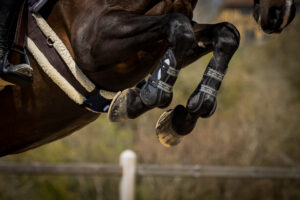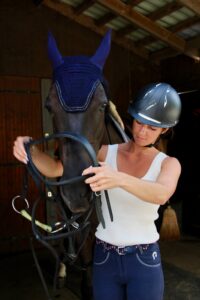Monday, May 23, 2022
Do you have a young horse? Or thinking of getting a young horse? Do you have a horse that's already been trained but with whom you'd like to brush up on the basics? In this article, you'll find tips and exercises for a successful jump breaking-in.
Before you start working your horse in the saddle, you're probably going to do some preliminary work on foot, and you're right.
At this stage of breaking-in, your horse is probably familiar with the ground bars. If this is not the case, it is absolutely essential to get him used to them. Start by having him pass a bar on the ground at walk pace, then move on to higher gaits and you can increase the number of bars on the ground as the sessions progress. Don't forget toadapt the distances between the ground bars to your horse's stride, especially at the beginning of the work!

If your horse is well-educated and foot codes are well established, a good way to introduce him to the bars is with shoulder work. You're going to need a little cardio, because you're going to have to run! Start with shoulder work as usual. Check that your horse is on command, and then start passing a bar across the ground at all three paces and with both hands.
The first obstacle you can climb is a small cross or vertical. We suggest that you take your companion at a trot on these first cavallettis. This will give him more time to grasp the obstacle.
Don't get angry if your horse is surprised at first and stops. Show him calmly. If you're used to working with targetsyou can use them. Since the obstacle is very low, you can encourage your horse to pass it from the step. For the more anxious, this technique allows you to keep the pressure off the gait.
Once your horse is comfortable with small cavallettis on the shoulder, you can move him away from you and work him in the lunge. You can then start to diversify exercises and start working on the jumps.
Always start with a few easy jumps in trot and canter. Don't hesitate to put bars bars perpendicular to your obstacles to frame your horse!

Visit setting bars are very useful for young horses. They allow you to mechanize your horse and get him to adopt the right jumping gesture, by breaking down his movement.
Don't forget to adapt the distances to your horse's stride. The examples given here are for a horse with a classic stride.
Put a foam bar 2.80m before a vertical. Let your horse find his place with this bar on the ground, then you can add one at the landing, between 2.80m and 3m behind, depending on how far your horse jumps.
Once your horse is used to a single vertical, you can build a line of verticals. Alternate between a vertical and a bar, always 3m apart.. This exercise is excellent for mechanizing horses.
Still on the subject of mechanizing your horse, the jumping is a highly formative exercise that enables the horse to learn become independent jumping.
Put a setting bar 2.8m before your first vertical, then leave 3.2m between the first and last vertical. The horse may be surprised by this exercise, which is not entirely natural for him. So be patient with him, as this exercise, although instructive, requires the horse to think.
If your horse rushes the jumping movement, shorten the distance with the adjusting bar so that you can approach at a trot.